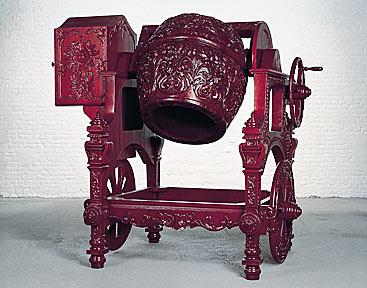
Born in 1965 in Wervik (BE)
Lives and works in Ghent(BE) and New York (US)

1991
Wood, red teak, stained varnish
186 x 181 x 145 cm
Year of Purchase: 1992
Wim Delvoye proceeds by way of association, collage, mixtures of ideas, and materials. He compares and contrasts things that belong to incompatible cultural fields, or fields that have become obsolete: symbols, customs and uses, practices and techniques. ‘With porcelain and a football goal, the gas bottle and the cement-mixer made of wood, I put myself up against the powerlessness of getting a lofty message across by way of a commonplace object. This is what I play with.’1
Delvoye effectively plays with and associates the life-size form of a cement-mixer, usually made of metal, with a craftsman-like technique involving carved wood. The tool-machine, a metaphor of the mix of ideas and cultures, is decorated with traditional decorative Flemish artwork. As a statement against the mean and petty minds and tastes of his fellow citizens, the Bétonneuse (Cement-Mixer) is also a condemnation of the channels of industrial manufacture of pseudo-craft objects – it was made by little Indonesian hands.
The object attracts and seduces by the quality of the handiwork, its function transcended by the decorative factor has become of minor interest, and anodyne. However, because the manufacturing conditions are mock-craftsman-like, it becomes a parody of the real identity of the object, a mask, a falsehood. In the artist’s hands, objects are fetishes with the value of icons, for they describe the arbitrariness of taste in a society where over-consumption is the order of the day.
Delvoye’s art nevertheless expresses all the complexity of the interactions between cultures. He is interested in the specific features of ‘Belgitude’, in the anecdote underpinning both the popularity of the icon and the particular reality of his country, by displaying the inanity and futility of its emblems. Out of derision, he incorporates the ordinary and the idea in the stuff of the modern artwork and thus perpetuates the atypical spirit of Belgian art from Brueghel to Broothaers by way of Magritte and Ensor.
Maïté Vissault
1 Interview with Nestor Perkal, in Wim Delvoye, Rochechouart, Departmental Museum, 1995, p. 28.